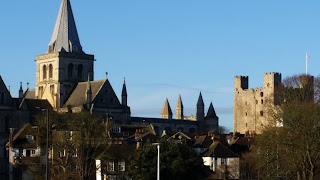"The miracle of life is not flying through the air or walking upon water, but walking upon the earth." (Old Chinese saying)
 |
| Tower Bridge near the Tower of London |
From 20 - 22 January, Mr Matthew Betts, Development Manager at the Shrine, walked from Westminster Abbey in London to Rochester Cathedral in Kent on a belated sponsored walk. The walk is to raise funds for the Order of Carmelites for their important work in the UK and abroad.
If you would like to sponsor Matt, please visit our page, here.
Matt followed the old pilgrimage route as outlined in the recent works of Rev John N Merrill who sets out an excellent path from London via Gravesend to Rochester. It is a pilgrimage route full of history, wonder and beauty. Matt was also very lucky, as although it was cold, it did not rain! Rain always makes it much harder to walk!
Matt started at Westminster Abbey. The Abbey has been the coronation church since 1066, and is the final resting place of seventeen monarchs. The church was begun by Henry III in 1245 and it is one of the most important Gothic buildings in the country, and has the medieval shrine of an Anglo-Saxon saint at its heart, Saint Edward the Confessor. The walk from here is full of history: Matt passed 10 Downing Street; the Cenotaph; before arriving at Trafalgar Square. Afterwards, Matt continued down the Strand, and passed the impressive St Mary le Strand church and the RAF church, Saint Clements Danes (not always RAF, Matt's 17/18th century ancestors worshipped here).
 |
| St Mary le Strand Church |
 |
| Saint Paul's Cathedral |
..and then kept walking along the river until he reached Southwark Cathedral (built in 1106). Matt then kept walking along the river to see views of Tower Bridge and the Tower of London until much later, reaching Greenwich. This is not the last time, the Thames will be seen.
On the route from Greenwich to Gravesend, there are some wonderful sites to see, including the view from the Old Observatory (see below); All Saints Church, Blackheath; and a particular favourite, Christ Church in Bexleyheath. At Christ Church, there were originally stained-glass windows depicting six apostles (though not Jude) and the intention had been to add the other six. However, and unfortunately, money ran out, and the six that had been added were destroyed in bombing during World War 2. It is a beautiful church and it is a good place to stop.
 |
| View of Greenwich |
This towpath follows the railway for a long time and is stunning countryside. The Thames and Medway Canal is a disused canal and was originally some 11 km (6.8 mi) long and cut across the neck of the Hoo peninsula, linking the River Thames at Gravesend with the River Medway at Strood.
 |
| The canal |
 |
| The railway alongside, which is crossed eventually |
Matt then arrived at Saint Mary's Church in Church Street (see below). This church dates from the 14th Century and was near a Priory of Benedictine Nuns. The Priory was one of the first to be dissolved under King Henry VIII in 1521.
After the village of Church Street, Matt walked the last few miles to Rochester. As he walked the hill to Strood, a final view of the Thames can be seen, soon it will be the river Medway!
 |
| The River Thames in the background |
This is very beautiful countryside - even in January - as can be seen in the photos below.
Finally, Matt reached Rochester by crossing the bridge from Strood. Rochester is at the lowest bridging point of the River Medway and is about 30 miles (though not when walking!) from London.
Rochester was for many years a favourite of Charles Dickens, who owned nearby Gads Hill Place, Higham, basing many of his novels on the area. The Diocese of Rochester, the second oldest in England, is centred on Rochester Cathedral and was responsible for the founding of a school, now The King's School in 604 AD, which is recognised as being the second oldest continuously running school in the world. Rochester Castle, built by Bishop Gundulf of Rochester, has one of the best preserved keeps in either England or France, and during the First Barons' War (1215–1217) in King John's reign, baronial forces captured the castle from Archbishop Stephen Langton and held it against the king, who then besieged it.
It is a very interesting town to wander around, especially as the walk was finally complete.
Thank you to all that sponsored Matt. If you still want to, please visit the page, here.
_____________________











No comments:
Post a Comment